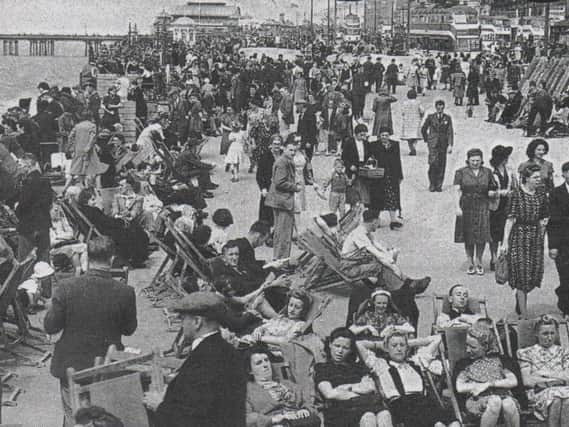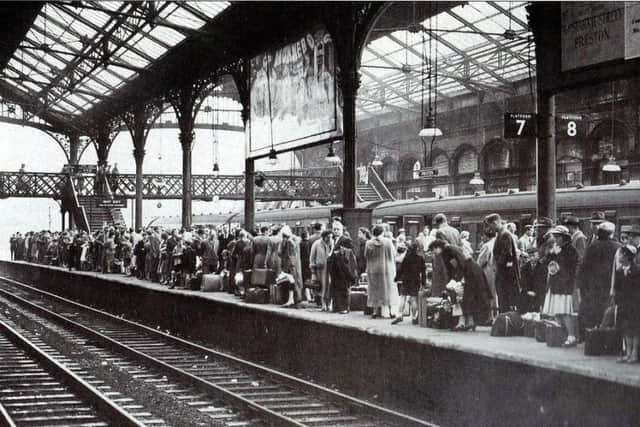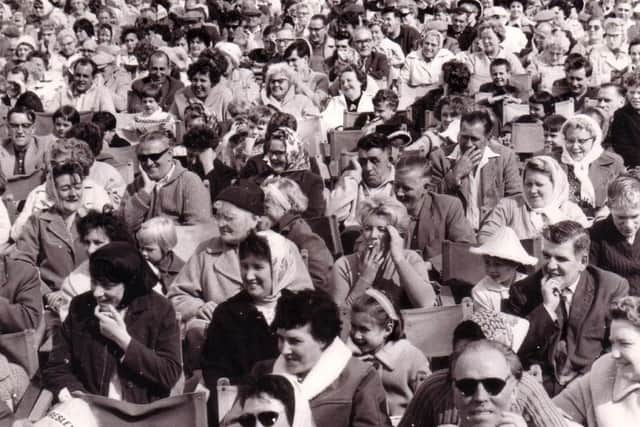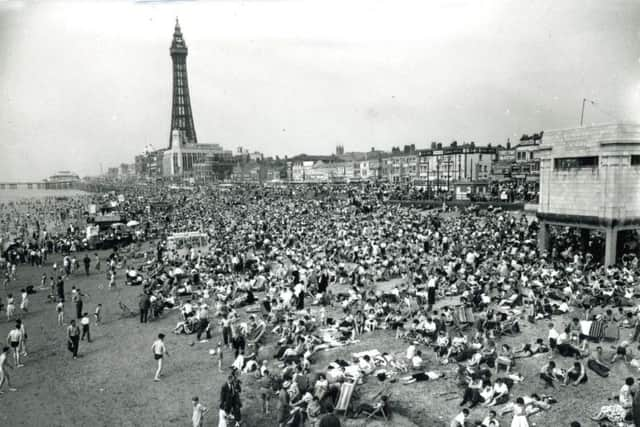When everyone in town had a seaside holiday together


Sixty years ago in early 1957, the Lancashire Evening Post printed a list of the Lancashire Wakes Weeks for the coming summer.
The fortnightly holiday breaks began in late June for the likes of Chadderton, Middleton and Oldham followed a week later by such as Bolton, Hindley Green and Westhoughton, who finished their break in early July.
Advertisement
Hide AdAdvertisement
Hide AdIt was then the turn of places such as Burnley, Bury, Colne, Wigan and Earby to make their trips to the seaside before Accrington, Blackburn, Chorley, Leyland, Clitheroe and Preston joined the holiday exodus in the last fortnight of July.


This was the fortnight when the mill chimneys stopped smoking and the wheels of industry were oiled and maintained ready for refreshed employees to resume production. Mills, factories, workshops and offices all falling silent.
A mass exodus of local folk to the seaside resorts of Lancashire and beyond was an annual occurrence. It was commonly known as the Wakes Weeks period when mill, factory, shops and offices alike closed and the workers took a well earned break.
Traditionally from 19th century days, the employers in the cotton trade had shut down their factories for two or three days to take the opportunity to service their machinery. It was not seen as an opportunity to give their loyal workers a break, but a necessity for maintenance work to be carried out. In those days it was no work therefore no pay and only those who had put some cash in savings schemes were able to spend an enjoyable vacation away from the grime and grit of the workplace.
Advertisement
Hide AdAdvertisement
Hide AdIn 1905 a significant change took place for Lancashire workers when the traditional Wakes Week was formally established.


Throughout the county it was agreed that an operatives holiday should be observed, in Preston’s case lasting the entire second week of August. The new holiday even being extended to the retail trade, with shops putting up the shutters for a week and leading department stores allowing their staff three or four days off.
Prior to the Second World War the Wakes Week became a great tradition throughout the Lancashire towns and the seaside resorts of Lancashire, in particular, prospered.
Yet it was only in the post-war years that one week became two, at which point the break was switched in Preston to the last fortnight in July. By this time, the workers had won the right to paid holidays and consequently the break was much more appreciated.
Advertisement
Hide AdAdvertisement
Hide AdThe hard working newsagents of Preston indulged themselves by continuing to shut up shop for the first week of the fortnight and the Lancashire Evening Post carried adverts showing where you could collect your evening newspaper around the town.


No rest for the printers or the publishing staff, though, but the paper lads got a well earned break. Extra copies of the LEP were sent to the local seaside resorts, so you could still enjoy the news from back home as you sat on deckchairs.
If we glance back at the summer of 1957 it very much reflected the traditions of Wakes Weeks. The early Wakes Weeks visitors to the seaside resorts enjoyed something of a heatwave, but by July the weather was showery and less sunny.
As regards the weather, Lancashire folk were brought up believing that if it rained on St Swithin’s Day, July 15, then it would rain for the next 40 days. Unfortunately, it was a wet one in 1957 and the showers followed with intermittent rain and overcast skies commonplace throughout the county.
Advertisement
Hide AdAdvertisement
Hide AdProblems with rain interruptions meant many of the Northern Cricket League matches were washouts during the fortnight, although Fleetwood did manage to win away at Preston between the showers.


To make matters worse, the start of the Preston Wakes coincided with a national bus strike over pay. Ribble Motors staff had an unexpected ‘busman’s holiday’ due to the dispute with 4,500 staff joining the picket lines.
The Ribble bus station on Tithebarn Street was virtually deserted, although the scheduled long distance and pre-booked holiday tours operated by Ribble had
departed early on the Saturday morning.
The drivers of the Scout Motor Services, who were not involved in the dispute, received a hostile reception as they passed a line of pickets who were mostly conductresses campaigning vigorously. The strike took a week to resolve and a wage increase of 11 shillings for drivers meant they returned to work happy with a week of hectic excursions to the likes of Llandudno, Chester Zoo and Morecambe ahead.
Advertisement
Hide AdAdvertisement
Hide AdThe scene at Preston railway station contrasted sharply with the bus station during that first week, with the platforms crowded with holidaymakers as extra trains were added to the
already busy schedule.


More than 50 excursion trains were fully booked with Fleetwood, Blackpool, Southport and Morecambe among the most popular destinations. Packed trains, often with standing room only, steamed off to the seaside and if you boarded a normal daily passenger service there were many stops along the way.
If you were on your way to Southport halts were made at Penwortham Cop Lane, New Longton, Longton Bridge, Hoole, Hesketh Bank, Hundred End, Banks, Crossens, Churchtown and Hesketh Park before journey’s end at Chapel Street.
Once at the seaside, if staying for a week in a boarding house with a landlady at your service or simply a day tripper, it was a case of fresh air and fun.
Advertisement
Hide AdAdvertisement
Hide AdMany a youngster carried a bucket and spade as the sands beckoned. Besides building sandcastles and collecting sea shells, if the tide was right a paddle in the sea was irresistible, along with a ride on a donkey.
The shouts and screams of the fairground would also grab your attention and merry-go-rounds aplenty attracted you, as did a stroll along the seaside piers where more attractions and entertainment were forthcoming. Temptations of candy floss, ice cream and a stick of rock all adding to the pleasure.
The desire to send a postcard or two, be they saucy or scenic, was compelling, although in 1957 the Preston post office warned they might be delayed a few days as the sorting office was undergoing some changes.
A request for ‘Post’ readers to send postcards from their travels led to a bulging postbag at the Fishergate offices. Cards from all over England and the Continent arrived including Paris, London, Brighton, Wales, Jersey, Austria and even one from Fulwood, where the Hothersall family had a stay at home holiday in York Avenue.
Advertisement
Hide AdAdvertisement
Hide AdDuring that first week of the Preston holidays, if you stayed at home and wanted to escape the showers then the local cinemas were only too happy to entertain you.
There were still 14 cinemas in town from the Empire, Ritz and Palladium on Church Street to the Savoy Cinema on Ashton Street and the Picturedrome in Brackenbury Place.
Among the films on offer, with double bills the order of the day, were ‘Guys and Dolls’ at the Ritz, ‘The Day They Gave Babies Away’ at the Gaumont, ‘Road To Denver’ at the Savoy and ‘Teenage Rebel’ starring Ginger Rogers at the Empire.
The Preston Horse Show held on Avenham Park during the holiday period was becoming quite an attraction by 1957 and thousands flocked to see the event. A number of Lancashire’s finest show jumpers participated and a couple of days later they were at the Royal Lancashire Show in Blackpool that attracted not only the horses but the finest cattle and sheep.
Advertisement
Hide AdAdvertisement
Hide AdAs the fortnight drew to a close with the Bank Holiday on August 5, the skies provided more prolonged spells of sunshine. The folk made their way back home. They had many happy memories of their holiday adventures to bring with them.
Although these days the school holidays usually start at the traditional time of Preston Holidays, the majority of commerce and industry carries on business as usual.